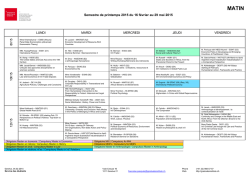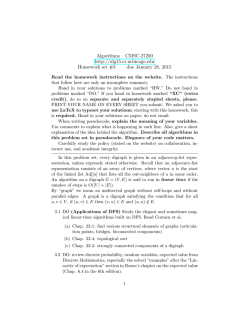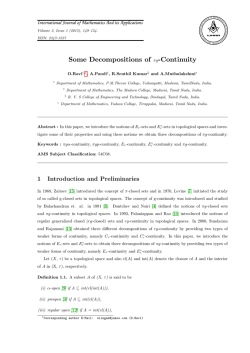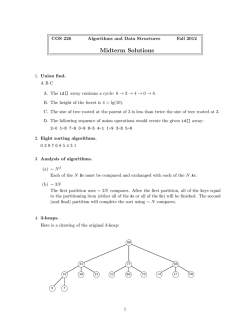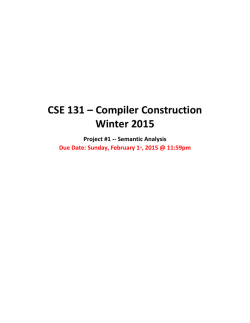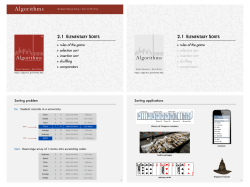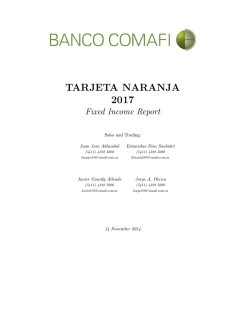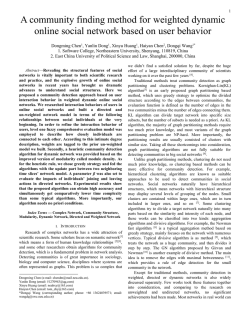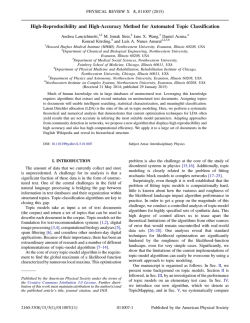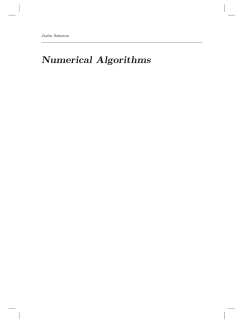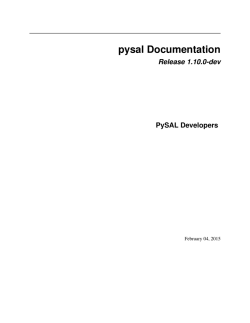
4up - Department of Computer Science
COS 226, S PRING 2015
COS 226 course overview
What is COS 226?
・Intermediate-level survey course.
・Programming and problem solving, with applications.
・Algorithm: method for solving a problem.
・Data structure: method to store information.
A LGORITHMS
AND
D ATA S TRUCTURES
KEVIN WAYNE
topic
data structures and algorithms
data types
stack, queue, bag, union-find, priority queue
sorting
quicksort, mergesort, heapsort, radix sorts
searching
BST, red-black BST, hash table
graphs
BFS, DFS, Prim, Kruskal, Dijkstra
strings
KMP, regular expressions, tries, data compression
advanced
B-tree, kd-tree, suffix array, maxflow
http://www.princeton.edu/~cos226
2
Why study algorithms?
Why study algorithms?
Their impact is broad and far-reaching.
Old roots, new opportunities.
・Study of algorithms dates at least to Euclid.
・Named after Muḥammad ibn Mūsā al-Khwārizmī.
・Formalized by Church and Turing in 1930s.
・Some important algorithms were discovered
Internet. Web search, packet routing, distributed file sharing, ...
Biology. Human genome project, protein folding, …
Computers. Circuit layout, file system, compilers, …
by undergraduates in a course like this!
Computer graphics. Movies, video games, virtual reality, …
Security. Cell phones, e-commerce, voting machines, …
Multimedia. MP3, JPG, DivX, HDTV, face recognition, …
Social networks. Recommendations, news feeds, advertisements, …
Physics. N-body simulation, particle collision simulation, …
3
2000s
1990s
1980s
1970s
1960s
1950s
1940s
1930s
1920s
825
300 BCE
⋮
4
Why study algorithms?
Why study algorithms?
To become a proficient programmer.
For intellectual stimulation.
FRO M THE
EDITORS
THE JOY OF ALGORITHMS
“ For me, great algorithms are the poetry of computation. Just
Francis Sullivan, Associate Editor-in-Chief
T
HE THEME OF THIS FIRST-OF-THE-CENTURY ISSUE OF COMPUTING IN
SCIENCE & ENGINEERING IS ALGORITHMS. IN FACT, WE WERE BOLD
ENOUGH—AND PERHAPS FOOLISH ENOUGH—TO CALL THE 10 EXAMPLES WE’VE SE-
like verse, they can be terse, allusive, dense, and even mysterious.
“ I will, in fact, claim that the difference between a bad programmer
But once unlocked, they cast a brilliant new light on some
and a good one is whether he considers his code or his data structures
aspect of computing. ”
more important. Bad programmers worry about the code. Good
— Francis Sullivan
LECTED “THE TOP 10 ALGORITHMS OF THE CENTURY.”
Computational algorithms are probably as old as civilization.
Sumerian cuneiform, one of the most ancient written records,
consists partly of algorithm descriptions for reckoning in base
60. And I suppose we could claim that the Druid algorithm for
estimating the start of summer is embodied in Stonehenge.
(That’s really hard hardware!)
Like so many other things that technology affects, algorithms have advanced in startling and unexpected ways in the
20th century—at least it looks that way to us now. The algorithms we chose for this issue have been essential for progress
in communications, health care, manufacturing, economics,
weather prediction, defense, and fundamental science. Conversely, progress in these areas has stimulated the search for
ever-better algorithms. I recall one late-night bull session on
the Maryland Shore when someone asked, “Who first ate a
crab? After all, they don’t look very appetizing.’’ After the usual
speculations about the observed behavior of sea gulls, someone
gave what must be the right answer—namely, “A very hungry
person first ate a crab.”
The flip side to “necessity is the mother of invention’’ is “invention creates its own necessity.’’ Our need for powerful machines always exceeds their availability. Each significant computation brings insights that suggest the next, usually much
larger, computation to be done. New algorithms are an attempt
to bridge the gap between the demand for cycles and the available supply of them. We’ve become accustomed to gaining the
Moore’s Law factor of two every 18 months. In effect, Moore’s
Law changes the constant in front of the estimate of running
time as a function of problem size. Important new algorithms
do not come along every 1.5 years, but when they do, they can
change the exponent of the complexity!
For me, great algorithms are the poetry of computation.
Just like verse, they can be terse, allusive, dense, and even
2
mysterious. But once unlocked, they cast a brilliant new light
on some aspect of computing. A colleague recently claimed
that he’d done only 15 minutes of productive work in his
whole life. He wasn’t joking, because he was referring to the
15 minutes during which he’d sketched out a fundamental optimization algorithm. He regarded the previous years of
thought and investigation as a sunk cost that might or might
not have paid off.
Researchers have cracked many hard problems since 1 January 1900, but we are passing some even harder ones on to the
next century. In spite of a lot of good work, the question of
how to extract information from extremely large masses of
data is still almost untouched. There are still very big challenges coming from more “traditional” tasks, too. For example, we need efficient methods to tell when the result of a large
floating-point calculation is likely to be correct. Think of the
way that check sums function. The added computational cost
is very small, but the added confidence in the answer is large.
Is there an analog for things such as huge, multidisciplinary
optimizations? At an even deeper level is the issue of reasonable methods for solving specific cases of “impossible’’ problems. Instances of NP-complete problems crop up in attempting to answer many practical questions. Are there
efficient ways to attack them?
I suspect that in the 21st century, things will be ripe for another revolution in our understanding of the foundations of
computational theory. Questions already arising from quantum computing and problems associated with the generation
of random numbers seem to require that we somehow tie together theories of computing, logic, and the nature of the
physical world.
The new century is not going to be very restful for us, but it
is not going to be dull either!
C O MPUTIN G IN S CIEN CE & E N GINEERIN G
programmers worry about data structures and their relationships. ”
— Linus Torvalds (creator of Linux)
5
6
Why study algorithms?
Why study algorithms?
They may unlock the secrets of life and of the universe.
To solve problems that could not otherwise be addressed.
“ Computer models mirroring real life have become crucial for most
advances made in chemistry today…. Today the computer is just as
important a tool for chemists as the test tube. ”
— Royal Swedish Academy of Sciences
(Nobel Prize in Chemistry 2013)
http://www.youtube.com/watch?v=ua7YlN4eL_w
Martin Karplus, Michael Levitt, and Arieh Warshel
7
8
Why study algorithms?
Why study algorithms?
・Their impact is broad and far-reaching.
・Old roots, new opportunities.
・To become a proficient programmer.
・For intellectual stimulation.
・They may unlock the secrets of life and of the universe.
・To solve problems that could not otherwise be addressed.
・For fun and profit.
For fun and profit.
Why study anything else?
9
10
Lectures
Lectures
Traditional lectures. Introduce new material.
Traditional lectures. Introduce new material.
Electronic devices. Permitted, but only to enhance lecture.
Flipped lectures.
・Watch videos online before lecture.
・Complete pre-lecture activities.
・Attend two "flipped" lecture per week
(interactive, collaborative, experimental).
・Apply via web by midnight today; results by noon tomorrow.
no
no
no
What
When
Where
Who
Office Hours
What
When
Where
Who
Office Hours
L01
MW 11–12:20
McCosh 10
Kevin Wayne
see web
L01
MW 11–12:20
McCosh 10
Kevin Wayne
see web
Andy Guna
see web
Frist 307
MW 11–12:20
L02
11
12
Precepts
Coursework and grading
Discussion, problem-solving, background for assignments.
Programming assignments. 45%
What
When
Where
Who
Office Hours
P01
Th 11–11:50
Friend 108
Andy Guna †
see web
P01A
Th 11–11:50
Friend 109
Shivam Agarwal
see web
P02
Th 12:30–1:20
Friend 108
Andy Guna †
see web
P03
Th 1:30–2:20
Friend 108
Swati Roy
see web
P04
F 10–10:50
Friend 108
Robert MacDavid
see web
P05
F 11–11:50
Friend 108
Robert MacDavid
see web
P05A
F 11–11:50
Friend 109
Shivam Agarwal
see web
P06
F 2:30–3:20
Friend 108
Jérémie Lumbroso
see web
P06A
F 2:30–3:20
COS 102
Josh Wetzel
see web
P06B
F 2:30–3:20
Friend 112
Ryan Beckett
see web
P07
F 3:30–4:20
Friend 108
Jérémie Lumbroso
see web
† lead preceptor
・Due at 11pm on Wednesdays via electronic submission.
・Collaboration/lateness policies: see web.
Exercises. 10%
・Due at 11pm on Sundays via Blackboard.
・Collaboration/lateness policies: see web.
Exams. 15% + 25%
・Midterm (in class on Wednesday, March 11).
・Final (to be scheduled by Registrar).
Participation
Final
Exam
Programming
Assignments
Midterm
Exam
Participation. 5%
Exercises
・Attend and participate in precept/lecture.
・Answer questions on Piazza.
13
14
Resources (textbook)
Required device for lecture.
Required reading. Algorithms 4th edition by R. Sedgewick and K. Wayne,
・Any hardware version of i▸clicker.
・Available at Labyrinth Books ($25).
・You must register your i▸clicker in Blackboard.
Addison-Wesley Professional, 2011, ISBN 0-321-57351-X.
save serial number
to maintain resale value
(sorry, insufficient WiFi in this room to support i▸clicker GO)
Algorithms
Which model of i▸clicker are you using?
F O U R T H
A.
i▸clicker.
B.
i▸clicker+.
C.
i▸clicker 2.
D.
I don't know.
E.
I don't have one yet.
1st edition (1982)
2nd edition (1988)
3rd edition (1997)
R O B E R T
S E D G E W I C K
E D I T I O N
K E V I N
W A Y N E
4th edition (2011)
Available in hardcover and Kindle.
・Online: Amazon ($60 hardcover, $50 Kindle, $20 rent), ...
・Brick-and-mortar: Labyrinth Books (122 Nassau St.).
・On reserve: Engineering library.
15
16
Resources (web)
Resources (people)
Course content.
Piazza discussion forum.
・Course info.
・Lecture slides.
・Flipped lectures.
・Programming assignments.
・Exercises.
・Exam archive.
・Low latency, low bandwidth.
・Mark solution-revealing questions
http://piazza.com/princeton/spring2015/cos226
as private.
Office hours.
・High bandwidth, high latency.
・See web for schedule.
http://www.princeton.edu/~cos226
Booksite.
・Brief summary of content.
・Download code from book.
・APIs and Javadoc.
http://www.princeton.edu/~cos226
Computing laboratory.
・Undergrad lab TAs.
・For help with debugging.
・See web for schedule.
http://algs4.cs.princeton.edu
http://labta.cs.princeton.edu
17
22
What's ahead?
Q+A
Today. Attend traditional lecture (everyone).
Not registered? Go to any precept this week.
Wednesday. Attend traditional/flipped lecture.
Change precept? Use SCORE.
Thursday/Friday. Attend precept (everyone).
All possible precepts closed? See Colleen Kenny-McGinley in CS 210.
FOR i = 1 to N
Haven't taken COS 126? See COS placement officer.
Sunday: two sets of exercises due.
Placed out of COS 126? Review Sections 1.1–1.2 of Algorithms 4/e.
Monday: traditional/flipped lecture.
Tuesday: programming assignment due.
Wednesday: traditional/flipped lecture.
protip: start early
Thursday/Friday: precept.
23
24
Algorithms
R OBERT S EDGEWICK | K EVIN W AYNE
Subtext of today’s lecture (and this course)
Steps to developing a usable algorithm to solve a computational problem.
model the
problem
1.5 U NION -F IND
try a
gain
design an
algorithm
‣ dynamic-connectivity problem
‣ quick find
Algorithms
F O U R T H
E D I T I O N
R OBERT S EDGEWICK | K EVIN W AYNE
understand
why not
‣ quick union
‣ improvements
efficient?
‣ applications
no
http://algs4.cs.princeton.edu
yes
solve the
problem
2
Dynamic-connectivity problem
Given a set of N elements, support two operation:
・Connection command: directly connect two elements with an edge.
・Connection query: is there a path connecting two elements?
1.5 U NION -F IND
‣ dynamic-connectivity problem
Algorithms
R OBERT S EDGEWICK | K EVIN W AYNE
http://algs4.cs.princeton.edu
add edge between 4 and 3
connect 3 and 8
connect 6 and 5
‣ quick find
connect 9 and 4
‣ quick union
connect 2 and 1
‣ improvements
are 8 and 9 connected?
✔
are 5 and 7 connected?
𐄂
‣ applications
0
1
2
3
4
5
6
7
8
9
connect 5 and 0
connect 7 and 2
connect 6 and 1
connect 1 and 0
are 5 and 7 connected?
✔
4
A larger connectivity example
Modeling the elements
Q. Is there a path connecting elements p and q ?
Applications involve manipulating elements of all types.
・Pixels in a digital photo.
・Computers in a network.
・Friends in a social network.
・Transistors in a computer chip.
・Elements in a mathematical set.
・Variable names in a Fortran program.
・Metallic sites in a composite system.
finding the path explicitly is a harder problem
(stay tuned for graph algorithms in Chapter 4)
p
When programming, convenient to name elements 0 to N – 1.
・Use integers as array index.
・Suppress details not relevant to union-find.
q
can use symbol table to translate from site
names to integers (stay tuned for Chapter 3)
A. Yes.
5
6
Modeling the connections
Two core operations on disjoint sets
We model "is connected to" as an equivalence relation:
Union. Replace set p and q with their union.
・Reflexive: p is connected to p.
・Symmetric: if p is connected to q, then q is connected to p.
・Transitive: if p is connected to q and q is connected to r,
Find. In which set is element p ?
then p is connected to r.
union(2, 5)
find(5) == find(6) ✔
{ 0 } { 1, 4, 5 } { 2, 3, 6, 7 }
Connected component. Maximal set of elements that are mutually connected.
3 disjoint sets
0
1
2
3
4
5
6
7
{ 0 } { 1, 2, 3, 4, 5, 6, 7 }
2 disjoint sets
{ 0 } { 1, 4, 5 } { 2, 3, 6, 7 }
3 disjoint sets
(connected components)
7
8
Modeling the dynamic-connectivity problem using union-find
Union-find data type (API)
Q. How to model the dynamic-connectivity problem using union-find?
Goal. Design an efficient union-find data type.
A. Maintain disjoint sets that correspond to connected components.
・Number of elements N can be huge.
・Number of operations M can be huge.
・Union and find operations can be intermixed.
・Connect elements p and q.
・Are elements p and q connected?
union(2, 5)
find(5) == find(6) ✔
{ 0 } { 1, 4, 5 } { 2, 3, 6, 7 }
public class UF
{ 0 } { 1, 2, 3, 4, 5, 6, 7 }
3 disjoint sets
initialize union-find data structure
UF(int N)
2 disjoint sets
with N singleton sets (0 to N – 1)
merge sets containing
void union(int p, int q)
connect 2 and 5
elements p and q
are 5 and 6 connected?
0
1
2
3
0
1
2
3
4
5
6
7
4
5
6
7
3 connected components
int find(int p)
identifier for set containing
element p (0 to N – 1)
2 connected components
9
10
Dynamic-connectivity client
・Read in number of elements N from standard input.
・Repeat:
– read in pair of integers from standard input
– if they are not yet connected, connect them and print pair
1.5 U NION -F IND
public static void main(String[] args)
{
int N = StdIn.readInt();
UF uf = new UF(N);
while (!StdIn.isEmpty())
{
int p = StdIn.readInt();
int q = StdIn.readInt();
if (uf.find(p) != uf.find(q))
{
uf.union(p, q);
StdOut.println(p + " " + q);
}
}
}
% more tinyUF.txt
10
4 3
3 8
6 5
9 4
2 1
8 9
5 0
already connected
7 2
(don't print these)
6 1
1 0
6 7
‣ dynamic-connectivity problem
‣ quick find
Algorithms
R OBERT S EDGEWICK | K EVIN W AYNE
http://algs4.cs.princeton.edu
11
‣ quick union
‣ improvements
‣ applications
Quick-find [eager approach]
Quick-find [eager approach]
Data structure.
Data structure.
・Integer array id[] of length N.
・Interpretation: id[p] identifies the set containing element p.
・Integer array id[] of length N.
・Interpretation: id[p] identifies the set containing element p.
union(6, 1)
id[]
0
1
2
3
4
5
6
7
8
9
0
1
1
8
8
0
0
1
8
8
id[i] = 0
{ 0, 5, 6 }
id[i] = 1
{ 1, 2, 7 }
id[]
0
1
2
3
4
5
6
7
8
9
0
1
1
1
8
8
0
1
0
1
1
8
8
problem: many values can change
id[i] = 8
{ 3, 4, 8, 9 }
3 disjoint sets
Q. How to implement find(p)?
Q. How to implement union(p, q)?
A. Easy, just return id[p].
A. Change all entries whose identifier equals id[p] to id[q].
13
Quick-find: Java implementation
Quick-find is too slow
Cost model. Number of array accesses (for read or write).
public class QuickFindUF
{
private int[] id;
public QuickFindUF(int N)
{
id = new int[N];
for (int i = 0; i < N; i++)
id[i] = i;
}
public int find(int p)
{ return id[p]; }
public void union(int p, int q)
{
int pid = id[p];
int qid = id[q];
for (int i = 0; i < id.length; i++)
if (id[i] == pid) id[i] = qid;
}
14
set id of each element to itself
(N array accesses)
algorithm
initialize
union
find
quick-find
N
N
1
number of array accesses (ignoring leading constant)
return the id of p
(1 array access)
Union is too expensive. Processing a sequence of N union operations
on N elements takes more than N 2 array accesses.
change all entries with id[p] to id[q]
(N+2 to 2N+2 array accesses)
quadratic
}
15
16
Quadratic algorithms do not scale
Rough standard (for now).
・10 operations per second.
・10 words of main memory.
・Touch all words in approximately 1 second.
a truism (roughly)
since 1950!
9
9
1.5 U NION -F IND
Ex. Huge problem for quick-find.
・10 union commands on 10 elements.
・Quick-find takes more than 10 operations.
・30+ years of computer time!
9
‣ dynamic-connectivity problem
9
18
‣ quick find
time
‣ quick union
Algorithms
quadratic
64T
‣ improvements
Quadratic algorithms don't scale with technology.
・New computer may be 10x as fast.
・But, has 10x as much memory ⇒
‣ applications
R OBERT S EDGEWICK | K EVIN W AYNE
32T
want to solve a problem that is 10x as big.
16T
・
With quadratic algorithm, takes 10x as long!
linearithmic
8T
size
http://algs4.cs.princeton.edu
limit on
available time
linear
1K 2K
4K
8K
17
Quick-union [lazy approach]
Quick-union [lazy approach]
Data structure.
Data structure.
・Integer array parent[] of length N, where parent[i] is parent of i in tree.
・Interpretation: elements in a tree corresponding to a set.
・Integer array parent[] of length N, where parent[i] is parent of i in tree.
・Interpretation: elements in a tree corresponding to a set.
0
1
2
3
4
5
6
7
8
9
0
0
1
9
4
9
6
6
7
8
1
9
6
7
4
p
find(i) = 9
1
2
3
4
5
6
7
8
9
0
1
9
4
9
6
6
7
8
9
0
union(3, 5)
9
2
0
8
5
1
9
2
3
6
4
p
5
7
8
q
3
parent of 3 is 4
root of 3 is 9
Q. How to implement union(p, q)?
{ 0 } { 1 } { 2, 3, 4, 9 } { 5, 6 } { 7 } { 8 }
3 disjoint sets (3 trees)
A. Set parent of p's root to parent of q's root.
Q. How to implement find(p) operation?
A. Return root of tree containing p.
19
20
Quick-union [lazy approach]
Quick-union demo
Data structure.
・Integer array parent[] of length N, where parent[i] is parent of i in tree.
・Interpretation: elements in a tree corresponding to a set.
0
1
2
3
4
5
6
7
8
9
0
1
9
4
9
6
6
7
8
9
6
0
union(3, 5)
1
6
9
5
7
8
q
only one value changes
2
0
4
1
2
3
4
5
6
7
8
9
3
p
Q. How to implement union(p, q)?
A. Set parent of p's root to parent of q's root.
0
1
2
3
4
5
6
7
8
9
0
1
2
3
4
5
6
7
8
9
21
Quick-union demo
22
Quick-union: Java implementation
public class QuickUnionUF
{
private int[] parent;
public QuickUnionUF(int N)
{
parent = new int[N];
for (int i = 0; i < N; i++)
parent[i] = i;
}
8
1
0
2
3
7
public int find(int p)
{
while (p != parent[p])
p = parent[p];
return p;
}
9
4
public void union(int p, int q)
{
int i = find(p);
int j = find(q);
parent[i] = j;
}
5
6
0
1
2
3
4
5
6
7
8
9
1
8
1
8
3
0
5
1
8
8
set parent of each element to itself
(N array accesses)
chase parent pointers until reach root
(depth of p array accesses)
change root of p to point to root of q
(depth of p and q array accesses)
}
24
Quick-union is also too slow
Cost model. Number of array accesses (for read or write).
algorithm
initialize
union
find
quick-find
N
N
1
quick-union
N
N†
N
1.5 U NION -F IND
worst case
‣ dynamic-connectivity problem
† includes cost of finding two roots
‣ quick find
worst-case input
4
Quick-find defect.
union(0, 2)
・
・Trees are flat, but too expensive to keep them flat.
Union too expensive (more than N array accesses).
3
‣ quick union
Algorithms
union(0, 1)
‣ improvements
union(0, 3)
‣ applications
union(0, 4)
R OBERT S EDGEWICK | K EVIN W AYNE
2
http://algs4.cs.princeton.edu
Quick-union defect.
・
・Find too expensive (could be more than N array accesses).
1
Trees can get tall.
0
25
Improvement 1: weighting
Weighted quick-union quiz
Weighted quick-union.
Suppose that the parent[] array during weighted quick union is:
・Modify quick-union to avoid tall trees.
・Keep track of size of each tree (number of elements).
・Always link root of smaller tree to root of larger tree.
quick-union
q
p
larger
tree
p
smaller
tree
might put the
larger tree lower
parent[]
0
1
2
3
4
5
6
7
8
9
0
0
0
0
0
0
7
8
8
8
reasonable alternative:
union by height/rank
0
1
2
3
8
4
5
7
9
q
smaller
tree
larger
tree
6
Which parent[] entry changes during union(2, 6)?
weighted
p
larger
tree
always chooses the
better alternative
p
q
q
smaller
tree
smaller
tree
larger
tree
Weighted quick-union
27
A.
parent[0]
B.
parent[2]
C.
parent[6]
D.
parent[8]
28
Weighted quick-union demo
0
1
2
Weighted quick-union demo
3
4
5
6
7
8
9
6
4
3
parent[]
0
1
2
3
4
5
6
7
8
9
0
1
2
3
4
5
6
7
8
9
parent[]
0
8
2
9
5
1
7
0
1
2
3
4
5
6
7
8
9
6
2
6
4
6
6
6
2
4
4
29
Quick-union vs. weighted quick-union: larger example
Weighted quick-union: Java implementation
Data structure. Same as quick-union, but maintain extra array size[i]
quick-union
to count number of elements in the tree rooted at i, initially 1.
quick-union
Find. Identical to quick-union.
Union. Modify quick-union to:
・Link root of smaller tree to root of larger tree.
・Update the size[] array.
average distance to root: 5.11
weighted
int i = find(p);
average distance to root: 5.11
weighted
int j = find(q);
if (i == j) return;
if (size[i] < size[j]) { parent[i] = j; size[j] += size[i]; }
else
{ parent[j] = i; size[i] += size[j]; }
average distance to root: 1.52
average distance to root: 1.52
Quick-union and weighted quick-union (100 sites, 88 union() operations)
Quick-union and weighted quick-union (100 sites, 88 union() operations)
31
32
Weighted quick-union analysis
Weighted quick-union analysis
Running time.
Running time.
・Find: takes time proportional to depth of p.
・Union: takes constant time, given two roots.
・Find: takes time proportional to depth of p.
・Union: takes constant time, given two roots.
in computer science,
lg means base-2 logarithm
Proposition. Depth of any node x is at most lg N.
Proposition. Depth of any node x is at most lg N.
in computer science,
lg means base-2 logarithm
Pf. What causes the depth of element x to increase?
Increases by 1 when root of tree T1 containing x is linked to root of tree T2.
・The size of the tree containing x at least doubles since | T | ≥
・Size of tree containing x can double at most lg N times. Why?
2
0
| T 1 |.
1
1
1
1
1
2
4
2
2
2
depth 3
2
T2
8
16
T1
x
x
N = 10
depth(x) = 3 ≤ lg N
lg N
⋮
N
33
34
Weighted quick-union analysis
Summary
Running time.
Key point. Weighted quick union makes it possible to solve problems that
・Find: takes time proportional to depth of p.
・Union: takes constant time, given two roots.
could not otherwise be addressed.
Proposition. Depth of any node x is at most lg N.
algorithm
worst-case time
quick-find
MN
quick-union
MN
weighted QU
N + M log N
algorithm
initialize
union
find
QU + path compression
N + M log N
quick-find
N
N
1
weighted QU + path compression
N + M lg* N
quick-union
N
N†
N
weighted QU
N
log N †
log N
order of growth for M union-find operations on a set of N elements
† includes cost of finding two roots
Ex. [109 unions and finds with 109 elements]
・WQUPC reduces time from 30 years to 6 seconds.
・Supercomputer won't help much; good algorithm enables solution.
35
36
Union-find applications
・Percolation.
・Games (Go, Hex).
・Least common ancestor.
✓ Dynamic-connectivity problem.
・Equivalence of finite state automata.
・Hoshen-Kopelman algorithm in physics.
・Hinley-Milner polymorphic type inference.
・Kruskal's minimum spanning tree algorithm.
・Compiling equivalence statements in Fortran.
・Morphological attribute openings and closings.
・Matlab's bwlabel() function in image processing.
1.5 U NION -F IND
‣ dynamic-connectivity problem
‣ quick find
Algorithms
R OBERT S EDGEWICK | K EVIN W AYNE
‣ quick union
‣ improvements
‣ applications
http://algs4.cs.princeton.edu
38
Percolation
Percolation
An abstract model for many physical systems:
An abstract model for many physical systems:
・N-by-N grid of sites.
・Each site is open with probability p (and blocked with probability 1 – p).
・System percolates iff top and bottom are connected by open sites.
・N-by-N grid of sites.
・Each site is open with probability p (and blocked with probability 1 – p).
・System percolates iff top and bottom are connected by open sites.
if and only if
percolates
blocked
site
does not percolate
open
site
open site connected to top
N=8
model
system
vacant site
occupied site
percolates
electricity
material
conductor
insulated
conducts
fluid flow
material
empty
blocked
porous
social interaction
population
person
empty
communicates
no open site connected to top
39
40
Likelihood of percolation
Percolation phase transition
Depends on grid size N and site vacancy probability p.
When N is large, theory guarantees a sharp threshold p*.
・p > p*: almost certainly percolates.
・p < p*: almost certainly does not percolate.
Q. What is the value of p* ?
1
p low (0.4)
does not percolate
p medium (0.6)
percolates?
p high (0.8)
percolates
percolation
probability
p*
0
0
empty open site
(not connected to top)
full open site
(connected to top)
N = 100
0.593
1
site vacancy probability p
blocked site
41
42
Monte Carlo simulation
Dynamic-connectivity solution to estimate percolation threshold
・Initialize all sites in an N-by-N grid to be blocked.
・Declare random sites open until top connected to bottom.
・Vacancy percentage estimates p*.
・Repeat many times to get more accurate estimate.
Q. How to check whether an N-by-N system percolates?
A. Model as a dynamic-connectivity problem problem and use union-find.
N=5
full open site
(connected to top)
empty open site
(not connected to top)
blocked site
pˆ =
204
= 0.51
400
N = 20
open site
43
blocked site
44
Dynamic-connectivity solution to estimate percolation threshold
Dynamic-connectivity solution to estimate percolation threshold
Q. How to check whether an N-by-N system percolates?
Q. How to check whether an N-by-N system percolates?
・Create an element for each site, named 0 to N
・Create an element for each site, named 0 to N – 1.
・Add edge between two adjacent sites if they both open.
2
2
– 1.
4 possible neighbors: left, right, top, bottom
N=5
0
1
2
3
4
5
6
7
8
9
10
11
12
13
14
15
16
17
18
19
20
21
22
23
24
N=5
open site
open site
blocked site
blocked site
45
46
Dynamic-connectivity solution to estimate percolation threshold
Dynamic-connectivity solution to estimate percolation threshold
Q. How to check whether an N-by-N system percolates?
Clever trick. Introduce 2 virtual sites (and edges to top and bottom).
・Create an element for each site, named 0 to – 1.
・Add edge between two adjacent sites if they both open.
・Percolates iff any site on bottom row is connected to any site on top row.
・Percolates iff virtual top site is connected to virtual bottom site.
N2
more efficient algorithm: only 1 connected query
virtual top site
brute-force algorithm: N 2 connected queries
top row
N=5
top row
N=5
bottom row
bottom row
open site
blocked site
open site
47
blocked site
virtual bottom site
48
Dynamic-connectivity solution to estimate percolation threshold
Dynamic-connectivity solution to estimate percolation threshold
Q. How to model opening a new site?
Q. How to model opening a new site?
A. Mark new site as open; add edge to any adjacent site that is open.
adds up to 4 edges
open this site
open this site
N=5
N=5
open site
open site
blocked site
49
blocked site
Percolation threshold
Subtext of today’s lecture (and this course)
Q. What is percolation threshold p* ?
Steps to developing a usable algorithm.
A. About 0.592746 for large square lattices.
・Model the problem.
・Find an algorithm to solve it.
・Fast enough? Fits in memory?
・If not, figure out why.
・Find a way to address the problem.
・Iterate until satisfied.
constant known only via simulation
1
percolation
probability
50
The scientific method.
Mathematical analysis.
p*
0
0
N = 100
0.593
1
site vacancy probability p
Fast algorithm enables accurate answer to scientific question.
51
52
© Copyright 2025
